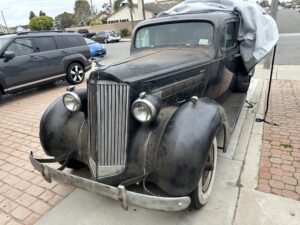
This 1937 Packard Series 115-C VIN Verification was done by our team member in Huntington Beach, Ca. on 4/28/2025

This 1937 Packard Series 115-C VIN Verification was done by our team member in Huntington Beach, Ca. on 4/28/2025
The 1937 Packard Series 115-C marked a significant chapter in Packard’s storied history as it introduced a more affordable, entry-level model aimed at broadening the brand’s appeal. Designed to bring Packard luxury to a wider audience during the tail end of the Great Depression, the 115-C was a bold step for a company known for producing premium vehicles. Despite its lower price point, it still carried the elegance and engineering excellence synonymous with the Packard name.
The Series 115-C was introduced in 1937 as the first Packard to use a six-cylinder engine since 1928. It was developed as a response to economic pressures and increased competition from more affordable luxury brands. The goal was to offer Packard prestige at a price point that made it accessible to the middle class, without compromising on the brand’s reputation for quality. The “115” referred to its 115-inch wheelbase, and the “C” denoted the third series of six-cylinder cars.
The Packard 115-C was powered by a 237 cubic inch (3.9-liter) inline six-cylinder engine producing approximately 100 horsepower. It was paired with a 3-speed manual transmission. While not built for speed, the engine provided smooth and reliable performance, with solid low-end torque suitable for the era’s driving needs. The car’s rear-wheel-drive layout and relatively light weight (for a Packard) made it nimble and comfortable to drive.
Stylistically, the 115-C shared design cues with its more luxurious siblings, including the signature Packard grille, streamlined fenders, and elegant chrome accents. It came in several body styles including two- and four-door sedans, coupes, convertibles, and touring models. Interiors featured quality materials for the time, such as mohair upholstery, woodgrain dash panels, and a clean, symmetrical gauge cluster. While simplified compared to Packard’s senior models, it still delivered a refined and stylish presentation.
The 1937 Packard 115-C came in a variety of body styles, which effectively acted as its trim levels. These included:
2-door Business Coupe
2-door Touring Coupe
2-door Convertible Coupe
4-door Touring Sedan
4-door Convertible Sedan
While mechanical specifications remained the same across variants, luxury and feature content varied by body style and customer customization. Buyers could also add optional features such as side-mounted spare tires, trunk racks, and custom interior trims.
Safety equipment on the 115-C reflected the standards of the era. Hydraulic brakes—new for Packard in 1937—were a significant advancement, providing better stopping power and more reliability than mechanical systems. Other features included safety glass for the windshield and basic lighting systems. Technological features were minimal, though buyers could opt for a factory-installed radio and clock—considered premium features at the time.
Fuel economy for the Packard 115-C was estimated at around 14 to 18 miles per gallon, which was reasonable for the time given the engine size and weight. The car’s six-cylinder engine was more economical than the larger straight-eights found in other Packard models, making it attractive to buyers concerned about running costs during economically challenging times.
The 115-C competed with other entry-level luxury or near-luxury vehicles such as the LaSalle Series 50, Buick Special, and Chrysler Royal. While some purists criticized the move as “cheapening” the Packard brand, the 115-C offered an unbeatable combination of prestige, value, and engineering quality. Its affordability made it a strong contender and broadened Packard’s customer base without sacrificing the elegance and dignity associated with the marque.
Base prices for the 1937 Packard 115-C started around $850 to $1,100 (roughly $18,000 to $24,000 in today’s dollars, adjusted for inflation), depending on body style and options. This positioned it well below Packard’s eight- and twelve-cylinder models and was considered a competitive price for a luxury-branded automobile with the Packard name.
While formal awards programs were limited in the 1930s, the Packard 115-C was praised in period publications for its affordability, ride quality, and elegant styling. In later decades, it has been recognized by classic car enthusiasts and collectors as a milestone model—one that preserved Packard’s integrity during challenging economic times and introduced the brand to a broader audience.
Need a VIN Verification? We are licensed to complete the REG 31 form. Call to get your car, truck or motorcycle verified today!
© 2025 QUICK VIN VERIFICATION. All rights reserved.